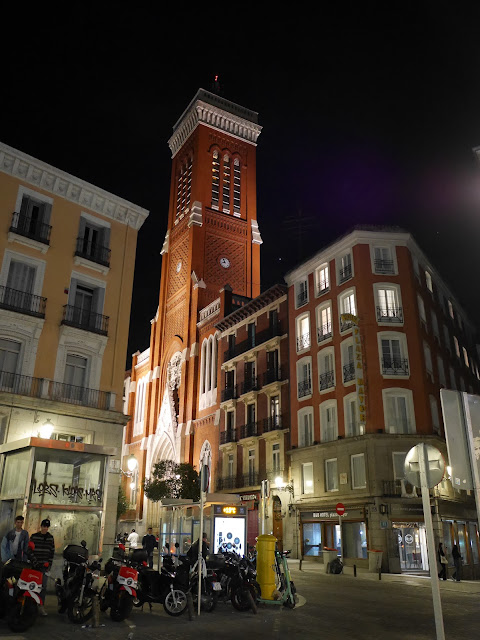The Thyssen Part II
In the 1960s, Hans Heinrich Thyssen-Bornemisza was buying up works by the German art groups Die Brucke (The Bridge) and Der Blue Reiter (The Blue Rider). In the '70s he started acquiring Surrealistic and Cubist works by Dali and Picasso, and really went all in on 20th-century American art, with works by Georgia O'Keeffe, Max Weber and Charles Demuth coming into the collection, followed by pictures by Hopper and the pop artists Robert Rauschenberg, Tom Wesselmann, James Rosenquist and Roy Lichtenstein.
Below is "Franzi in Front of a Carved Chair" (1910) by the wildly underappreciated Ernst Ludwig Kirchner. He was a co-founder of The Bridge, meant to be a link between classical art and the avant-garde. Its members distorted reality for emotional effect and worked extremely fast, sometimes taking only 15 minutes to capture a scene.
The Bridge was the gateway to northern European Expressionism (think Edvard Munch's "The Scream"). I do not know why Kirchner is not a household name. Most people who think about these things for a living consider him the most important German artist of the 20th century. Mountain views got his blood running, and you can see his unusual color choices jump off the canvas in "Alpine Kitchen" (1918).
Rich clients stopped buying his works when the Nazis denounced them as un-German. Feeling trapped and seeing the Third Reich destroy hundreds of his paintings, he walked outside his mountain home and shot himself in the heart.
I'd also like to say a few words about Andre Freakin' Derain (1880-1954), because he could do it all. Here's his "Waterloo Bridge" (1906), where he's applying thick dabs straight from the tube during his Pointillist period. This was a guy who, as an engineering student, would sketch at the Louvre in his spare time. When his work was first shown in 1905, a newspaper critic described him as a "wild beast," which must have delighted him. That's how Fauvism got its name.
"The Church in Chatou" (1909), the city of Derain's birth, has a primitive, Cezanne-like quality ― firmly Post-Impressionistic. What I like about it so much is that I think I could make it. These are just shapes, after all ―none of this greenery is articulated. It almost looks like it was painted by jigsaw. If I learned a little about composition and how to mix oils and wield a palette knife, it's within my grasp! I think about this a lot in museums. There is still time, as Felix Cavaliere of the Rascals sings, to "discover who you really am."
After four long years in uniform during World War I, Derain shed his Fauvist, Cubist leanings and became a classicist, emulating Corot and the other great masters. What happened out there on the battlefield?
The crowds thinned out a lot on the second floor.
The Thyssen kindly brackets subject matter. These florals are by, from left, Max Beckmann, Kirchner and Emile Nolde. It was around this point when I started thinking that the Thyssen must have the world's most important private collection of paintings.
Egon Schiele's "Houses on the River" (1914).
A weltering "Red Flowers" by Emil Nolde (1906) puts me in mind of a collapsing star just before it explodes outward. It's also reminiscent, energy-wise, of some of Miro's whirling red and white lithographs at the Reina Sofia.
Kandinsky's "In the Bright Oval" (1925).
Dali's "Dream Caused by the Flight of a Bee Around a Pomegranate a Second Before Waking Up" (1944).
Max Ernst's "Thirty-Three Little Girls Set Out for the White Butterfly Hunt" (1958).
You don't see a lot of 19th century American paintings in Europe, but the Thyssen has a generous number of portraits, streams and meadows, snow pines, marshes and swamps by a roll call of American masters: Winslow Homer, John Singer Sargent, Charles Wilson Peale, Thomas Cole, Frederic Church. For the viewer, these are not nearly as anguished or hard-won as the modern offerings on the second floor. Sort of like a cool-down period after a workout.
Winslow Homer's "Waverly Oaks" (1864).
Sargent's "Portrait of Millicent, Duchess of Sutherland" (1904).
I watched six bulls die Friday night. To clear my head, I walked two hours back to my apartment, and man, the streets were packed with drinkers raising freedom pints and yawping unintelligibly. The Fauvists would have approved ― grab life by the throat, and all that. Maybe the stadium cheers were still ringing in my ears, but there were these inky striations in the sky and people were yelling their heads off, and it didn't feel right, like when you're swimming in the ocean and wondering what beasts below are eyeing you.
I've known this for a long time but the ideas crystallized for me that 1.) I prefer daytime to nighttime, 2.) my sensibilities are more aligned with quiet, curious seekers like the art collector Hans Heinrich, and 3.) that the only diving I want to do here is into the past at this city's three great museums ― El Prado, the Reina Sofia and the Thyssen. There, you can walk through the chambers of an afterlife beyond the passions of this one. And as great as Madrid is ― believe me, once seen, never forgotten ― it is an exhausting place.
 |
| Baron H.H. Thyssen-Bornemisza, as painted by Lucian Freud in "Portrait of a Man." |














